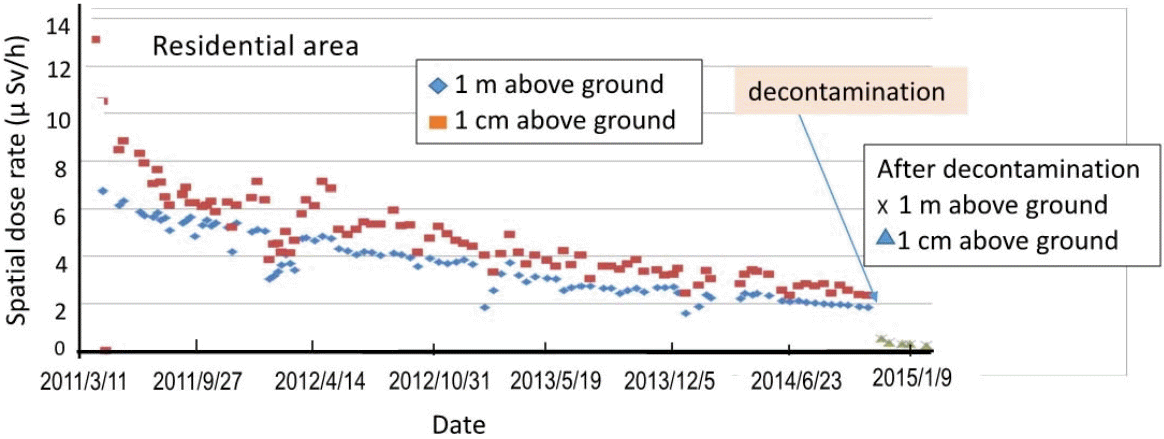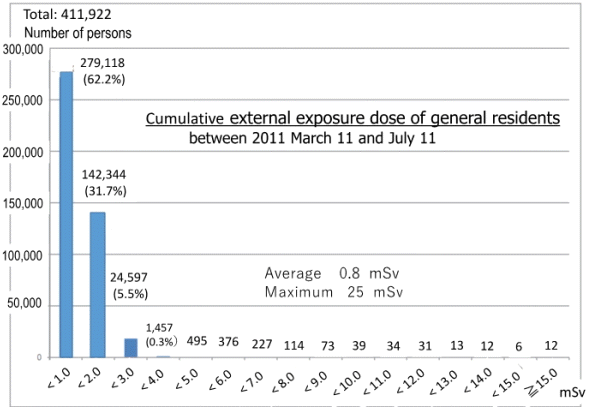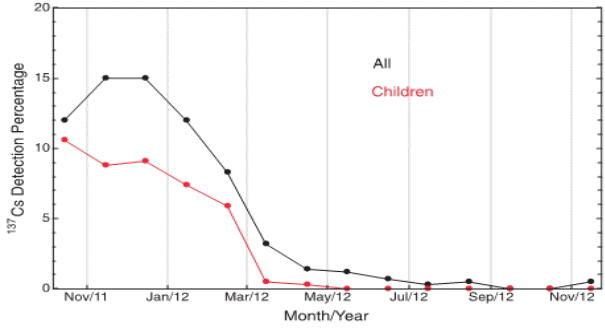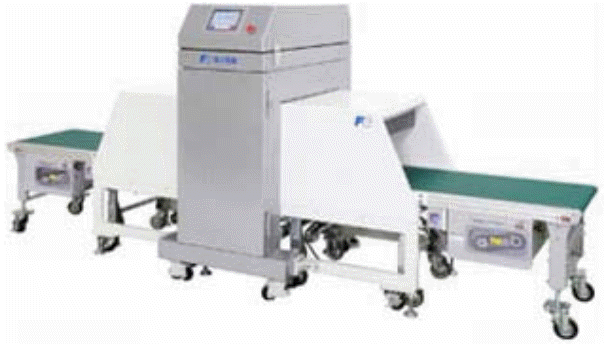AbstractBackground:The accident at Fukushima Daiichi Nuclear Power Plant (NPP), March 2011, caused serious radioactive contamination over wide area in east Japan. Therefore, it is important to know the effect of the accident and the status of NPP.
Materials and Methods:This paper provides a review on the status of radiation dose and radioactive contamination caused by the accident on the basis of publicized information.
Results and Discussion:Monitoring of radiation dose and exposure dose of residents has been conducted extensively by the governments and various organizations. The effective dose of general residents due to the accident proved to be less than a mSv both for external and internal dose. The equivalent committed dose of thyroid was evaluated to be a few mSv in mean value and less than 50 mSv even for children. Monitoring of radioactivity concentration has been carried out on food ingredients, milk and tap water, and actual meal. These studies indicated the percentage of foods above the regulation standard was over 10% in 2011 but decreasing steadily with time. The internal dose due to foods proved to be tens of μSv and much less than that due to natural 40K even in the Fukushima area and decreasing steadily, although high level concentration is still observed in wild plants, wild mushrooms, animals and some kind of fishes.
1. INTRODUCTIONFour years have passed since the accident of Fukushima Daiichi Nuclear Power Plant (NPP) of Tokyo Electric Power Co. Ltd (TEPCO), March 2011. The amount of radioactivity emitted, was estimated by various institutions and the maximum values was ~9.0×1017 Bq (iodine equivalent) [1]1), which corresponds to about 18% of the Chernobyl case. It was ranked as level 7 in International Nuclear and Radiological Event Scale (INES) of International Atomic Energy Agency (IAEA) which is the same level as the Chernobyl accident on the basis of the amount of radio activities released to the environment. It should be noted that, in the case of Fukushima Daiichi NPP, the release of strontium, uranium and plutonium isotopes were much less compared with the Chernobyl case and was comparable with the fall out due to nuclear tests in ‘50-60s2)-3). A marked amount of radioactivity was released also to the ocean because of leakage of highly contaminated water from the reactor cores and ejection of low level contaminated water in the storage volume. It leads to needs of long term monitoring of marine contamination4).
Various works have been undertaken for monitoring of radiation dose and radioactive contamination, investigation of pathway of contamination and recovery of environment, health management of residents including thyroid inspection, as well as stabilization and decommissioning of NPP. The major component of radiation dose and contamination was 131I just after the accident and changed to 134Cs and 137Cs in the middle of April, 2011. The amounts of emitted 134Cs and 137Cs were almost the same in radioactivity (Bq). The monitoring results indicated that the actual decrease of radiation dose was generally faster than expected probably because of a weathering effect except for forest area where ecological half-life is longer5). In parallel with the monitoring, efforts were given for estimating the effective dose and equivalent dose for thyroid. Internal exposures dose from inhalation and foods intake proved to be much less than external ones owing to low concentration of radioactivity in air and the food ingredients. In addition, health management survey was started for evacuees and residents in Fukushima and neighboring prefectures6). Efforts were taken for decontamination of houses, public buildings and grounds of schools.
Extensive monitoring has been taken for foods and drinks. Foods and drinks with radioactivity concentration higher than Provisional Standards Limit given by the Japanese government in March 17, 2011 and new Standard Limit in April 1, 2012 were required to restore from shipment. Monitoring of actual meals was also carried out as well by various organizations and local governments.
This paper presents a brief review on 1) radiation and dose and exposures of residents, and 2) radioactive contamination of foods and drinks due to the accident of the Fukushima Daiichi NPP. Investigations on the contamination pathways, efforts for reduction of contamination, and environmental recovery are also described.
2. STATUS OF RADIATION DOSE RATE AND EXPOSURE2.1 Monitoring of spatial dose and exposureSystematic monitoring of radiation dose rate has been conducted by using fixed position monitors like monitoring posts, airplane and new mobile type monitors for distribution measurements. Figure 1 shows the variation of air dose rate in Fukushima city. The air dose rate was, as shown in Fig.1, dominated by 131I (T1/2 = 8 d) for about one month after the accident and then by 134, 137Cs with longer half-lives (2 and 30 years, respectively).
Figure 2 shows variation of air dose rate in Iitoi district of the Iitate–village, Fukushima prefecture, where all the residents were ordered to evacuate because of high dose rate. The data are shown both for residential area and farm area, and for 1 m and 1 cm heights. The figure indicates the dose rate decreased steadily as expected from the physical decay of main components, 134, 137Cs and weathering. The fluctuation of data reflects the effect of snow fall. The sudden decrease indicated by arrows is due to the decontamination works which were undertaken mainly by eliminating a surface layer of soil down to ~5 cm7). The effectiveness of the decontamination depends on the environment but it is more effective for residential area.
2.2 Exposure dose estimationAs a part of health management survey by the Fukushima Prefecture, radiation exposure dose of general residents was estimated by two ways. One is based on the information where the residents were during the period of high spatial (air) dose rate after the accident, the spatial dose rate and radioactivity concentration data in that area. The other is an actual measurement of external and internal exposure using personal-dosimeters and whole-body counters, respectively. The exposure dose estimated with the former procedure was consistent with the data by the actual measurements.
The results of external effective dose of general residents except for radiation workers from March 11 to July 11, 2011 when the radiation dose rate was high, is shown in Figure 3. This was estimated assuming that people stay 8 hours outside and 16 hours inside a house with a shielding factor of 0.4. Fig. 3 indicates that the exposure dose is less than 1 mSv for most residents (~99%), and the maximum value was ~25 mSv. The mean value was 0.8 mSv.
The external exposure dose measured by personal dosimeter showed similar temporal trend with those estimated from spatial dose rate, but proved to be significantly lower than that estimated from the spatial dose rate by around 40%. One reason of the difference was attributed to the uncertainties in the duration staying in house and shielding factor of buildings, but the response of the personal dosimeters was also in question because personal dosimeters are calibrated for AP (anterior-posterior) geometry whereas the radiation field due to the accident is almost isotropic. It was confirmed by Hirayama et al., by using Monte Carlo simulations with the EGS code, that the readings of the personal dosimeter will give higher values than the effective dose, i.e., conservative values, even in an isotropic radiation field.
The internal exposure dose was estimated on the basis of the whole-body counter data at various institutes and organizations with priority on children and pregnant women. The results in the Fukushima prefecture are shown in Table 1. The data are taken three monthes or more after the accident, then the data indicate only the effect of 134Cs and 137Cs from foods and drinking water. The effect of short lived 131I is evaluated separately as discussed below.
The table indicates that the internal exposure dose due to cesium isotopes during July to December, 2011, was less than a few mSv in committed effective dose and decreased with elapsed time. Figure 4 shows temporal change of the percentage of 137Cs detection in the whole-body counter measurement, which indicates that the detection probablity of 137Cs decreased rapidly in particular for chiledren having more active matabolism. These data are also consistent with the fact that the cesium concentration in foods and meals are very low, presented in sect. 3 on Status of Radioactive contamination. It should also be noted that various independent measurements were generally consistent each other.
The internal exposure dose due to 131I which was dominant just after the accident and relevant to tyroid canser is not included in Table1, and was evaluated separately. Tokonami et al. estimated the equivalent dose for thyroid due to 131I from the actual measurement during the end of March and April, 2011 for 46 evacuees and residents [4]. The results are shown in Fig.5. The median and maximum thyroid doses were, respectively 4.2 and 23 mSv for children, and 3.5 and 33 mSv for adults. The Ministry of Environment estimated the thyroid dose on the basis of the routs analysis after the accident to be less than ~100 mSv. Therefore, estimated thyroid dose is much less than the mean thyroid dose in the Chernobyl evacuees, 490 mSv owing to immediate evacuation and rapid fall out of activities due to rainfall and/or snowfall.
2.3 Health management surveyAs a part of health management survey program, inspection of thyroid cancer was conducted for residents younger than 18 at the time of the accident from Oct. 2011 March 31, 2015 with ultrasound (US) devices. If the result of the thyroid cyst or lump was outside the regular range in the preceding inspection, secondary and full inspection was conducted. Until the end of March 2015, inspection has been done for 299,543 residents.
Among them, 112 residents were diagnosed to be malignant or suspicious case. The data are as follows: Male/Female = 38/74, mean age =17.2 and no malignant or suspicious cases for 0-5 years old group, mean tumor size=14.2 mm (7.8). For 99 cases, surgery was conducted, and it was reported that all was typical one for adults unlike in Chernobyl. At present, it is unlikely that these thyroid cancers are due to radiation from the Fukushima accident because 1) estimated thyroid dose is lower than ~50 mSv in Fukushima, 2) the incidence is too early after the accident compared with the Chernobyl case (~5 years), 3) no malignant cases for 0-5 years old group in Fukushima which was highest in Chernobyl, 4) the inspection results in other prefectures of Aomori, Yamanashi and Nagasaki show similar number of anomalies, 5) the type of cancer is typical one for adults and different from Chernobyl ones. Further inspection will be continued.
3. STATUS OF RADIOACTIVE CONTAMINATIONAfter the very large release of radio activities on March 15, 2011, contamination of foods, water and drinks became apparent not only in the area close to NPP but also region far from NPP like Tokyo (>200 km from the NPP)8). Various actions were taken for monitoring, investigation of pathways and countermeasures for contamination and cleanup and/or remedy of environment including decontamination.
3.1 Standard limit for radioactivity concentration in foodsOn March 17, Ministry of Health. Laborer and Welfare (MHLW) established provisional standards for radioactivity concentration in foods9). The provisional standards were based on the constraints of 5 mSv·y-1 for internal dose due to foods and drinks. The standard value for radioactive cesium (sum of 134Cs and 137Cs) was 500 Bq·kg-1 for general foods. This value included contributions of other radionuclides of concern like strontium and plutonium etc.
On April 1, 2012, MHLW enforced a new standard limit to reduce the internal dose from foods to less than 1 mSv·y-1 10). The age-dependence of the effective dose conversion factor for internal exposure and food intake were taken into account, and a new category “infants foods” was introduced.
As shown in Table 2, the Japanese new standard limit is very low compared with other countries in particular USA and EU. These big differences come mainly from the difference in the assumption on the percentage of contaminated foods: In Japanese standard limit, contamination percentage is assumed to be 50% and 100% for general foods and drinking water, respectively, while they are 10% in EU and CODEX Committee, and 30% in USA. In all standard limit, the dose constraints from food is 1 mSv except for 5 mSv of USA.
3.2 Monitoring of foodsMonitoring of foods and waters was initiated just after the accident in various prefectures by the sampling method, and contamination exceeding the provisional standards was found frequently for vegetables, milk and water in Fukushima and neighboring areas. The Japanese government ordered shipment restraint for these foods. In this period, the contamination was mainly due to 131I with short life, and the contamination source changed rather rapidly to 134Cs and 137Cs with longer life, and the percentage of contamination decreased correspondingly.
Monitoring was extended to cover major food species in central and local governments, and organizations. These measurements were carried out with the standard measurement techniques employing NaI(Tl) scintillation spectrometers and Ge semiconductor spectrometers with heavy shield and standards U8 bottle or Marinelli beakers, shown in Figure 6. The NaI(Tl) detectors were used mainly for screening purposes with detection limit of several Bq·kg-1, while Ge spectrometers are used for high precision monitoring with lower detection limit (~1 Bq·kg-1 or less). In these measurements, usually, foods are minced and measured according to the standard procedure. The standard procedure enables high precision measurement but is time taking and not suitable for inspection of a large amount of materials in non-destructive manner. To enable nondestructive and automatic inline measurement of brown rice bag, a new device of conveyer-type was developed using face-to-face flat scintillators and shielding shown in Figure 711). This type of device contributed greatly for efficient screening measurement of rice that is fundamental food in Japan, and enabled screening of all brown rice bags to be shipped to markets. The rice unit with concentration higher than screening level (usually around 50 Bq·kg-1) is served to high precision measurement.
In addition, for nondestructive screening measurement of vegetables, meat and fishes, other type nondestructive devices were developed and used widely for inspection of fishes and home-made vegetables and so on12).
3.3 Status of radioactive contamination of foodsIn this section, typical results of food monitoring are shown.
For drinking water, contamination above the standard limit occurred even in Tokyo. However, it was due to 131I and disappeared shortly. Since the end of March 2011, contamination of drinking water was not found for both tap-water and well-water owing to filtering in filtration plant and by soil, respectively.
Table 3 summaries the temporal change of percentage of foods exceeding the standard limit in percentage (%)13). The table indicates that the foods above the standard limit have decreased steadily with time after the accident. It should be noted that the increase in 2012 of fishery products is due to the decrease of the standard limit in April 1 of 2012, and if this fact is taken into account, the contamination levels of foods greatly decreased from 2011 to 2012. The table also indicates that higher cesium concentration is seen in wild plants, mushroom and fishery products as was experienced in Chernobyl.
Table 4 shows a summary of the results of all brown rice bag measurement14). As shown in the table, the brown rice bags which exceeded the standard limit were of very small fraction in the order of 10-6 to 10-7 for 2012-2014 and zero in 2015. Such results owe to the efforts of farmers, researchers and local governments to reduce radioactivity concentration in foods, and also nature of soils in Fukushima as mentioned in the next section.
Figure 8 shows the results for inspection for marine products in Fukushima prefecture from 2012 to 201615). The percentage above the standard limit has steadily decreased with time down to less than 1% in 2014 and zero in 2015. For marine products, the cesium concentration is not generally high because the osmotic pressure of fish is higher than sea water, and higher concentration is seen to fishes which survived after intake of highly contaminated sea water just after the accident. On the other hand, for freshwater fishes, cesium concentration is higher than marine fishes because of higher osmotic pressure of river water16).
3.4 Monitoring of mealsIn parallel to the inspection of food materials, direct measurements of daily meals and school lunches have also been carried out in various organizations to know actual exposure dose from foods contamination. In these studies, meals from a family is minced, mixed and measured using Ge detectors with detection limit around 1 Bq·kg-1. For example, the inspection by the Japanese Consumer Co-operative17) showed that the ratio of meals above the detection limit was two among 100 samples in Fukushima prefecture even in earlier half of 2012, and decreased steadily to zero in 2014. Besides, detected activities were not high, and the highest cesium concentration was 1.9 Bq·kg-1 which corresponded to around one tenth of naturally-occurring 40K. Consequently, the annual internal exposure dose will be a few tens of μSv even if these meals are taken continuously through a year. Other investigations also showed similar results. In addition, inspection of meals by the Fukushima prefecture18) [5] reported the data on strontium concentration, and the result was 0.0017 mSv·y-1 which is less than one tenth of cesium (0.028 mSv·y-1). The 40K concentration corresponded to ~0.99 mSv·y-1.
From these results, internal exposure dose from foods contamination was estimated to be less than a few tens of μSv per year even in the Fukushima area and less than one tenth of that due to 40K.
3.5 Investigation of pathways of radioactivity transfer to foodsIn parallel with monitoring of radioactive contamination, investigation on the pathway of radioactivity contamination was conducted.
For agricultural products like vegetables and fruits, three major contamination pathways were identified: 1) contamination of leaf or plant itself by radioactivity, 2) transfer from the soil via roots, and 3) transfer through bark and/or cortex in fruits. The contamination just after the accident was attributed to the type 1). The information was applied effectively to reduce the transfer of radio activities to foods. It also proved that clay nature of soils around Fukushima prevents radioactive cesium from transferring to plants from soil. Furthermore, addition of appropriate amount of potassium fertilizer to soil proved effective to reduce cesium transfer.
In the case of fishes, the feature is different between marine fish and freshwater fishes because of osmotic pressure difference. In marine fishes, the ratio of cesium concentration between fish bodies and seawater is around 5 to 100 because the osmotic pressure of seawater is higher than fishes, and biological condensation does not occur strongly. In the case of freshwater fishes, however, the situation is contrary and the ratio can be as high as 400 to 3,000 and biological condensation can occur. Actually, higher concentration is observed for freshwater fishes like brook trout, sweet fish etc.
The radioactive contamination of beef occurred in 2011, was traced to be due to a feed of contaminated rice straw, and solved thereafter.
Generally, foods above the standard limits are found in wild plants, mushrooms and wild animals like boars which intake cesium isotopes from soil strongly, as experienced in Chernobyl.
4. SUMMARYA brief summary was presented on the status of radiation dose and radioactive contamination due to the accident of Fukushima Daiichi NPP in March 2011.
A large amount of radio activities, about 18% of the Chernobyl accident was emitted, but the amount of strontium and plutonium isotopes was much less.
Exposure dose due to the accident was traced by various methods, and proved to be an order of a few mSv both for external and internal effective dose, and less than ~50 mSv for thyroid dose. In particular, internal exposure dose due to intake of foods is estimated to be in the order of tens of μSv since the latter half of 2011, owing to extensive monitoring and shipment restraint of foods when radioactivity concentration exceeded the standard limit. Investigation and countermeasures were also undertaken effectively on the pathway for radioactivity transfer to foods.
Information on contamination pathways and how to reduce the contamination is accumulated and used for restoration of environment.
Notes11) http://www.an.shimadzu.co.jp/prt/foodseye/index.htm (in Japanese), http://www.fujielectric.co.jp/products/radiation/servy/nmu.html 17) http://jccu.coop/topics/radiation/intakeresult.html (in Japanese) 18) Three-years results and future scope of the Fukushima thyroid ultrasound examination after the Fukushima NPP accident. http://www.fmu.ac.jp/radiationhealth/survey/suzuki201409.html REFERENCES2. Hideo H. An evaluation of personal dosimeter for widely distributed 134Cs and 137Cs by using EGS code. Radioisotopes. 2013;62(6):335-345.
3. Hayano RS, Tsubokura M, Miyazaki M, Satou H, Sato K, Masaki S, Sakuma Y. Internal radiocesium contamination of adults and children in Fukushima 7 to 20 months after the Fukushima NPP as measured by extensive whole-body-counter surveys. Proc. Jpn. Acad., Ser. 2013;89(4):157-163.
4. Shinji T, Masahiro H, Suminori A, Atsuyuki S, Ikuo K, Mikhai B. Thyroid doses for evacuees from the Fukushima nuclear accident. Scient. Rep. 2012;2(507):1-4.
Fig. 2.Variation of spatial dose rate in Iitoi-district of Iitate village in Fukushima prefecture. (http://www.fujielectric.co.jp/products/radiation/servy/nmu.html) 
Fig. 3.External exposure dose of general residents in Fukushima prefecture due to the accident between March 11 to July 11, 2011. 
Fig. 4.Temporal change of 137Cs detection percentage for all and children in whole-body inspection in Fukushima prefecture. 
Fig. 7.An example of conveyor type in-line monitor for brown rice bags.(http://www.fujielectric.co.jp/products/radiation/servy/nmu.html) 
Table 1.Internal Exposure Dose Estimated from the Whole-body Counter Data in Fukushima Prefecture (mSv in commited effective dose)
Table 2.Comparison of Standard Limits of Cesium Concentration in Foods and Drinking Water [Bq·kg-1] Table 3.Temporal Change of Percentage of Foods above Standard Limit of Cesium Concentration in Percentage (%) |
|
||||||||||||||||||||||||||||||||